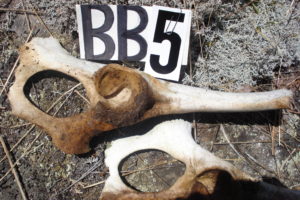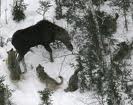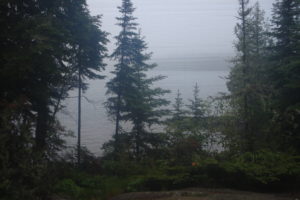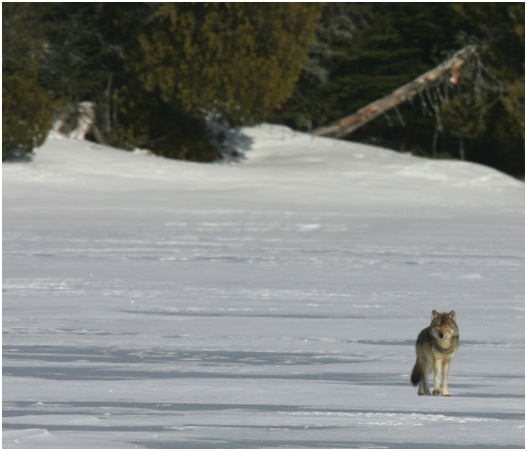Kathy Lyndes, a friend of mine, and her partner are drawn to the lives of wolves. They just came back from eight days on Isle Royale, assisting in a project to track wolf habits and habitats. The whole trip seemed so fascinating, and yet so physically challenging, that I asked her to share the adventure with you. So what follows is my first guest blog.
In June, 2010, my partner, Louis, and I were two of seventeen volunteers to collect moose bones as part of the fifty year Isle Royale wolf-moose research project, the longest running predator-prey study in the world. The experience was an 8-day backpacking and hiking trip in areas of Isle Royale rarely seen by the average visitor.
On the fourth day of our trip, we walked through a quarter inch carpet of moose hair, the area about the size of a small bedroom. This was the only kill sight we saw where parts of the skeleton were still intact, including one set of leg bones from the femur to the hoof. It was amazing to see, especially since all other moose bones we found were scattered; a wolf may carry the pelvis to the den for the cubs to play with, and scavengers may move bones as far apart as 70 or more yards. Apparently moose hooves rank on wolves’ good eats scale almost as highly as moose’s internal organs and noses. This was better than any science course I ever took and a backpacker’s paradise. That’s right: sanctioned off trail hiking, and I felt like an early prospector finding gold. Problem was, this was the trip where my beloved thirty year old hiking boots decided to call it quits, and, as a result, I had two feet with festering blisters and a mouth of choice swear words that I don’t use even in Chicago traffic.
On the last day of the trip, we had to hike 8 miles with our 40+ pound packs to get back to base camp. Greenstone Trail, a 40 mile path that runs the middle ridge of Isle Royale reaching heights of close to 1400 feet, is one of the most scenic footpaths I’ve ever seen, sometimes overlooking Isle Royale interior lakes and Lake Superior at the same time. Tears rolled down my cheeks, though, not from the beauty of my surroundings but from the pain. In between my alternating crying and swearing fits, I tried to sing, “Put one foot in front of the other” (remember that song from the old stop-motion flick Santa Claus Is Coming to Town?), but if it weren’t for Louis making sure I wasn’t alone should I break a leg, I’m not sure how I would have made it back to camp. His company and his jokes fortified me.

As several of the other volunteers admitted, this was the most physically and emotionally challenging hiking and backpacking they had ever done. We had tramped through a cedar bog only to find ourselves slipping up to our knees in water in an old beaver dam, the habitat changing as rapidly as it does in Chicago, from the mansions in the Kenwood neighborhood where President Obama owns a home to the poverty-stricken projects on the south side of the Loop only a few blocks away.
We had been warned that the trip would be arduous, but, after 12 weeks of intensive training, I hadn’t banked on my stamina not being sufficient. I’ve consistently exercised for years, run marathons, backpacked in the Boundary Waters and Sylvania Wilderness, and written a dissertation, which has nothing whatsoever to do with Isle Royale backpacking except that it, too, was a challenging process that involved impressive strings of swear words. Still, I hadn’t expected to be the slowest trekker in my group. Worst of all, I wasn’t prepared to feel cautious of the wilderness; I’ve hiked and camped off trail before, and here on Isle Royale, we didn’t have to worry about poison ivy, poison oak, ticks, or poisonous snakes (there are only two non-poisonous snakes on Isle Royale). Still, at age 47, I was surprised to experience dread – both realistic and unrealistic – about being left alone or getting lost, about twisting my ankle or worse, about being uncomfortable from the combination of rain, sweat, smelly latrines, and pine needles down my neck. Maybe, I thought to myself, I just don’t like being outdoors after all, and, out of spite, I swore to the nature gods that I would buy a gas guzzling Hummer H3 Alpha and never again would I “Recycle, Reuse, Reduce.”
I met one backpacker, Will, who, at age twenty had wisdom that has stayed with me. He took it for granted that when he camped, he’d wake up every two hours. Why is that some folk, like Will, accept that poor sleep is just part of the wilderness experience and is worth it for the sheer pleasure of being outdoors, while others, even if we don’t whine (much), add to our wretchedness with our LFT (what I teach in my psych courses as Low Frustration Tolerance)?
My father said that this Isle Royale trip was for the young, but there was a 57 year old volunteer as well as the legendary 72 year old who had returned nearly every year for 19 years. So I concluded that this trip is for those who have attitudes like Will’s, and I aspire to accept that discomfort, even pain, is part of living, not in some romanticized way, but in a realistic acknowledgement of limits. I also know that I managed to cope because of my team’s patience and good-natured spirits: Rob gave me high fives after particularly difficult terrain; Ben, our leader whose speed rivals that of cheetahs, helped me through a rough beaver pond when I was dehydrated; and Velda told stories, including those of army training jingles (“If you don’t mind, it don’t matter!”), that kept us in stitches. Any time I found myself thinking, “I can’t…” or “I don’t know how…” I was inspired by them to soldier on, not that I ever gave up on my fantasy of being air-lifted off Isle Royale.
In my better moments on and off trail, I took comfort in my skills as a slower, more methodical researcher, but finding a moose bone was often the luck of location and light. One time, I was only two feet away from Rob who found a bone just after I had walked near it. Yet bones are amazing story tellers despite who finds them, with every set of bones chronicling a unique narrative about its life, death, and relationships with wolves. Sometimes the moose died from starvation. We novices could tell because the bones weren’t gnawed, and experts could tell because the bone marrow was so low in fat content.
When the moose did die from wolf attacks, we’d check the pelvis, if we could find it, for signs of arthritis; if a moose was arthritic, its lower hip socket had fused shut or become misshapen. Ben showed us an older bull moose whose teeth were so worn and full of gingivitis that he (the moose, not Ben) had serious need of national dental health care coverage. We also learned a bit about how lesions on the skull demonstrate the presence of osteoporosis. 12 years is old for a moose
In a recent Wall Street Journal article (May 29-30, 2010), I read how some decent, caring folk in Wisconsin are afraid that their kids are going to be attacked by gray wolves. I can understand their frustration when wolves eat one of their pets or steers (one person who said she lost her hound to a wolf, reportedly led the resolution calling on the state of Wisconsin to cut the wolf population from 700 to 350), but why do we turn to fear instead of to facts when making choices about hunting and trapping wolves? We’ve taken away their habitat and then wonder why they attack our livestock. There are no documented reports of healthy wolves harming humans; they aren’t the senseless killers they’re sometimes still portrayed to be. Wolves are selective hunters, typically picking the weakest and most ill. On Isle Royale, they have to be selective to avoid getting thrown against a tree or receiving a broken rib from the stronger, more agile moose’s front hooves (no wonder wolves find moose hooves delectable). It takes as many as ten attempts for wolves to find a moose weak enough to bring down. One of the head researchers on the project, Rolf Peterson, in his book, “The Wolves of Isle Royale,” recounts his witness of a blind moose who kept off a pack of wolves for three days until they got tired and went to look for food elsewhere. 4 years is old for a wolf. 
The other common thoughts about wolves, that they kill just for pleasure and are wasteful hunters, are also myths. In fact, wolves kill because they’re hungry, and rarely do they leave a kill uneaten, facts which make them genetically unrelated to me who often buys food in wasteful packaging and sometimes eats not from necessity but for comfort. If moose are plentiful and relatively easy to kill, wolves sometimes do leave a moose carcass less than ravaged, however, this bounty then leaves more food for scavengers such as ravens, eagles, and foxes. There has to be solutions to the problem of wolves killing livestock that benefit both humans and wolves.
It was oddly disconcerting to be swearing off camping ever again, only to find myself taking detailed notes on my team’s gear for my next trip. The whole experience was profoundly humbling, both in terms of all there is to learn about nature and its unpredictability, and in terms of learning from those who graciously accepted challenges. If nothing else, this trip may have helped me to finally accept that I am, indeed, aging. One of my favorite psychologists, Heinz Kohut, calls this acceptance of limits a transformation of narcissism, and I feel just a bit less easily ruffled about growing older as a result of this trip. Though the verdict is still out whether I’ll ask to participate in this most amazing study again, I hope to live to a ripe old age, and I wonder if someday a researcher will be able to tell what I’ve learned – and how I’ve lived – by studying my bones. 110 years is old for a human.




